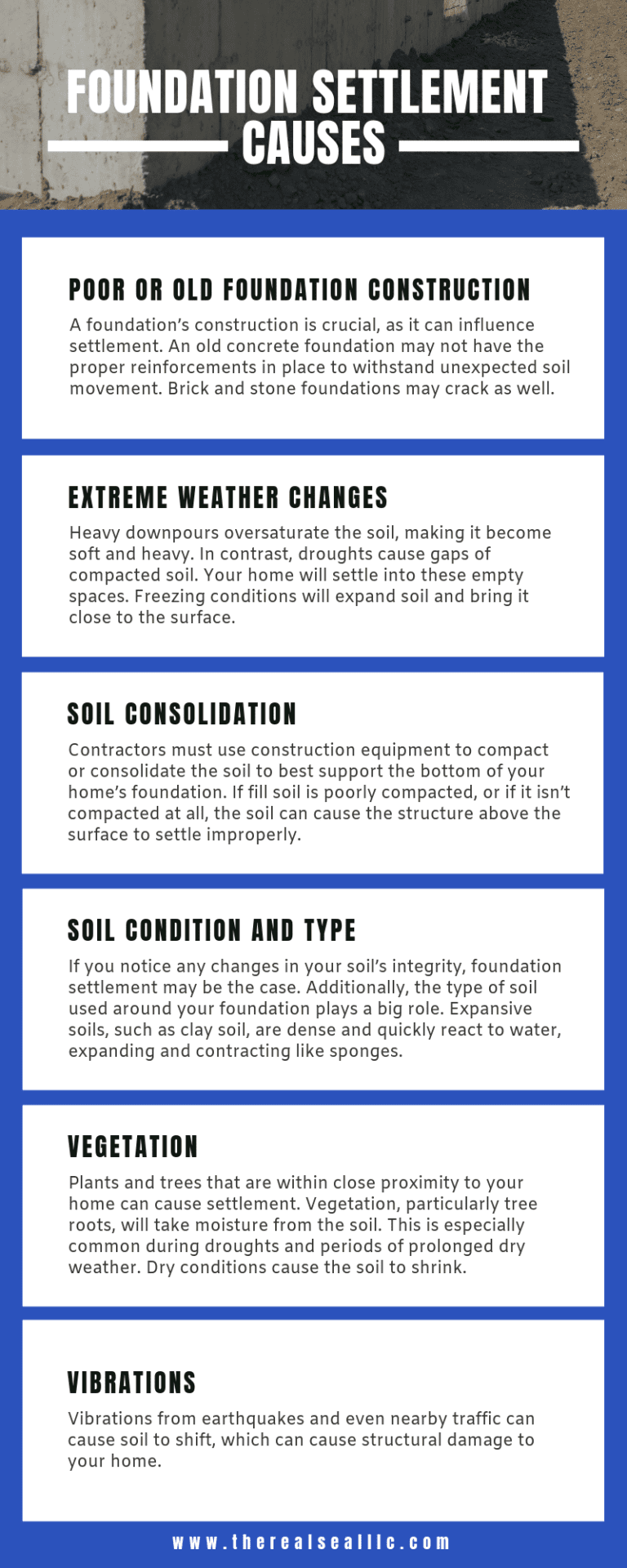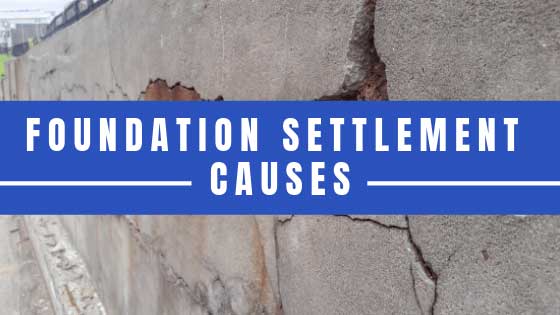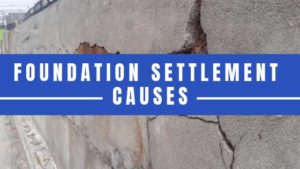Is your foundation settling? There are numerous reasons why this is the case. At times, it’s not something to worry about. However, if too much settlement is left untreated, it can damage your foundation and eventually the rest of your home. We identify the common causes of foundation settlement and point out the warning signs that you should look for when you inspect your home.
Foundation Settlement Causes
From natural factors to manmade mistakes, several causes can lead to foundation settlement.
Poor or Old Foundation Construction
A foundation’s construction is crucial, as it can influence settlement. An old concrete foundation may not have the proper reinforcements in place to withstand unexpected soil movement. Brick and stone foundations may crack as well.
Furthermore, the design of the footings can affect settlement. Instead of general construction, the footings must be designed and laid in to distribute the soil across weaker soils, which will reduce potential settlement.
Plus, improper foundation installation will only lead to problems down the road. Quality construction ensures that settlement will evenly distribute across the structure and that a few inches of settlement won’t be a concern.
Extreme Weather Changes
Natural changes in the weather can also cause foundation settlement. Heavy downpours oversaturate the soil, making it become soft and heavy. In contrast, droughts cause gaps of compacted soil. Your home will settle into these empty spaces. Freezing conditions will expand soil and bring it close to the surface.
Soil Consolidation
Your soil plays a huge role in supporting your home. Contractors must use construction equipment to compact or consolidate the soil to best support the bottom of your home’s foundation. If fill soil is poorly compacted, or if it isn’t compacted at all, the soil can cause the structure above the surface to settle improperly.
Soil Condition and Type
Your building’s weight naturally compresses the soil underneath it, forcing water out and making it dense. And because it’s inevitable that the weight of the foundation will compress the soil, this pressure is going to affect your soil’s condition. While you can’t change the type of soil under your foundation, if you notice any changes in your soil’s integrity, foundation settlement may be the case.
Additionally, the type of soil used around your foundation plays a big role. Expansive soils, such as clay soil, are dense and quickly react to water, expanding and contracting like sponges. On the other hand, loam and sandy soils drain better, contracting and expanding less than expansive soils. It may even be possible that your home’s design wasn’t adapted to the type of soil underneath it.
Another factor is your soil’s moisture. You’ll notice that, near the foundation’s perimeter, the soil is drier. But, conversely, too much moisture softens soil and weakens it. Let’s say you have a water leak—this built-up moisture will soften the soil along your foundation’s footing, and your foundation will settle. Depending on your soil’s composition, whether it’s too dry or too wet, it’ll cause hydrostatic pressure (a strong force of water that pushes against your basement walls).
Vegetation
Plants and trees that are within close proximity to your home can cause settlement. Vegetation, particularly tree roots, will take moisture from the soil. This is especially common during droughts and periods of prolonged dry weather. Dry conditions cause the soil to shrink.
Tree roots are the biggest culprit because they’re always in search of water, and they’ll slowly grow around and under your home’s foundation. You’ll mostly see soil dehydration issues with shallow foundations that are closer to the surface. This is because these structures are more susceptible to ground movement, as basement-level foundations extend deep down.
Vibrations
Vibrations from earthquakes and even nearby traffic can cause soil to shift, which can cause structural damage to your home.

Foundation Settlement Warning Signs
Settlement will take a while to happen—it can take weeks, months, or even years. But as the foundation moves downward, it cracks and can even face structural damage. Because of new trees or other factors, some signs may not become apparent until several years after the construction your home. If you see any of the signs we mention below, take action as soon as possible. Catching these signs early will ensure you reduce damage.
Bowed Foundation Walls
The Concrete Foundations Association (CFA) states that over 60% of foundation problems involve bowed basement walls, which are caused by soil shifting and pushing against your home.
Difficulty Opening and Closing Doors and Windows
If your doors and windows feel like they’re stuck, this could be from the pressure beneath the surface. This sign is more common in older homes, and it signifies that there’s a moisture issue. Because your home is settling, doors and windows won’t quite fit within their frames. To ensure they close properly again, consider calling your local foundation professionals and requesting their expertise and services.
Noticeable Foundation Cracks
Some cracks are normal, but ones that grow over time are problematic. You’ll need to pay special attention to the direction, location, and size of each crack. In most cases, horizontal or stair-step cracks in foundation walls are an obvious sign of settlement.
Uneven Floors
Slanted floors can indicate a myriad of issues. But, often, uneven floors are associated with foundation problems. If your floors seem uneven, be sure you have a professional come out and inspect them.
How to Prevent Foundation Settlement
Unfortunately, all houses settle over time due to gravity. But the good news is that you can prevent severe damage (and repair costs that range from $500 to $3,000) by taking preventive measures. First, ensure your home has a proper drainage system. This way, water won’t build up around your foundation and cause the soil to swell. Additionally, make sure gutters are clear and downspouts point away from your home. Finally, you should control vegetation; for instance, you can install root barriers or plant shrubs that require less water.
If you notice any of these signs, we suggest professional foundation repair. A foundation piering service from a reputable company will keep your foundation supported in its original position in the soil. To schedule our service, call The Real Seal today.






